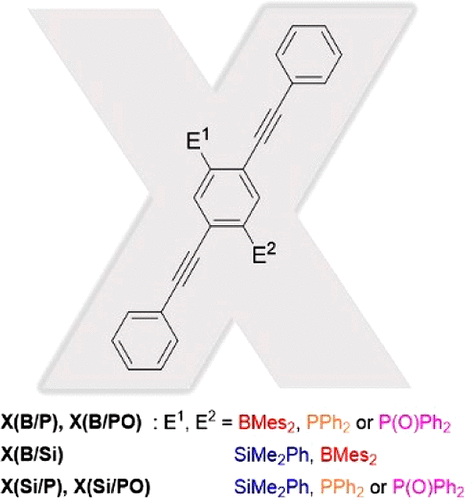当前位置:
X-MOL 学术
›
Organometallics
›
论文详情
Our official English website, www.x-mol.net, welcomes your feedback! (Note: you will need to create a separate account there.)
Synthesis and Photophysical Properties of Phenyleneethynylenes Containing a Combination of Two Main Group Element Moieties of B, Si, or P on the Side Chain
Organometallics ( IF 2.8 ) Pub Date : 2018-01-11 00:00:00 , DOI: 10.1021/acs.organomet.7b00768 Takanobu Sanji 1 , Akemi Fuchigami 1 , Masato Tanaka 1
Organometallics ( IF 2.8 ) Pub Date : 2018-01-11 00:00:00 , DOI: 10.1021/acs.organomet.7b00768 Takanobu Sanji 1 , Akemi Fuchigami 1 , Masato Tanaka 1
Affiliation

|
X-shaped 1,4-phenyleneethynylenes containing a combination of two main group element moieties of B, Si, or P as part of the side chain have been synthesized. The halogen–lithium exchange of 2-bromo-5-dimethylphenylsilyl-1,4-bis(phenylethynyl)benzene followed by addition of fluorodimesitylborane or chlorodiphenylphosphine gave the “X-shaped” B/Si and Si/P, respectively. The P-containing molecule was oxidized to afford a P(═O) derivative. The B/PO moieties were introduced to the 1,4-phenyleneethynylene unit by 3 steps, i.e., the halogen–lithium exchange of 2,5-dibromo-1,4-bis(trimethylsilylethynyl)benzene followed by sequential addition of fluorodimesitylborane and chlorodiphenylphosphine oxide, desilylation, and the Sonogashira coupling with aryl iodides. Then, the reduction of the B/PO gave “X-shaped” B/P derivative. The absorption and fluorescence spectra of the “X-shaped” molecules showed the molecules have two-dimensional conjugation systems, i.e., the π-conjugation of the original π-conjugation backbone and p(B)π–π* conjugation of B, σ*−π* conjugation of Si, and n−π and σ*−π* conjugation of P, extended from the π-core. The highest occupied molecular orbital (HOMO)–lowest unoccupied molecular orbital (LUMO) energy levels are significantly altered because of a lowering of the LUMO level due to p−π* conjugation for B and σ*−π* conjugation for Si and P compared with the parent phenyleneethynylene, which are also supported by density functional theory calculations.
中文翻译:

侧链上含B,Si或P两个主族元素部分的苯撑乙炔撑的合成及光物理性质
合成了包含B,Si或P的两个主族元素部分的组合作为侧链一部分的X形1,4-亚苯基亚乙炔基。2-溴-5-二甲基苯基甲硅烷基-1,4-双(苯基乙炔基)苯的卤素-锂交换,然后添加氟代二甲基异戊烷或氯代二苯基膦,分别得到“ X形” B / Si和Si / P。含P的分子被氧化以提供P(= O)衍生物。通过3个步骤将B / PO部分引入1,4-亚苯基亚乙炔基单元,即2,5-二溴-1,4-双(三甲基甲硅烷基乙炔基)苯的卤素-锂交换,然后依次添加氟代二甲基三茂硼烷和氯代二苯基膦氧化,去甲硅烷基化和Sonogashira与芳基碘化物偶联。然后,B / PO的还原得到“ X形” B / P衍生物。“ X形”分子的吸收和荧光光谱表明,该分子具有二维共轭体系,即原始π共轭骨架的π共轭和B(σ)的p(B)π–π *共轭Si的*-π*共轭,P的n-π和σ*-π*共轭,从π核扩展。由于B的p-π*共轭和Si和P的σ*-π*共轭,导致LUMO能级降低,因此最高占据分子轨道(HOMO)-最低未占据分子轨道(LUMO)能级发生了显着变化。母体亚苯基亚乙炔基,这也得到密度泛函理论计算的支持。Si的σ*-π*共轭,P的n-π和σ*-π*共轭,从π核扩展。由于B的p-π*共轭和Si和P的σ*-π*共轭,导致LUMO能级降低,因此最高占据的分子轨道(HOMO)-最低的未占据分子轨道(LUMO)能级发生了显着变化。母体亚苯基亚乙炔基,这也得到密度泛函理论计算的支持。Si的σ*-π*共轭,P的n-π和σ*-π*共轭,从π核扩展。由于B的p-π*共轭和Si和P的σ*-π*共轭,导致LUMO能级降低,因此最高占据的分子轨道(HOMO)-最低的未占据分子轨道(LUMO)能级发生了显着变化。母体亚苯基亚乙炔基,这也得到密度泛函理论计算的支持。
更新日期:2018-01-11
中文翻译:

侧链上含B,Si或P两个主族元素部分的苯撑乙炔撑的合成及光物理性质
合成了包含B,Si或P的两个主族元素部分的组合作为侧链一部分的X形1,4-亚苯基亚乙炔基。2-溴-5-二甲基苯基甲硅烷基-1,4-双(苯基乙炔基)苯的卤素-锂交换,然后添加氟代二甲基异戊烷或氯代二苯基膦,分别得到“ X形” B / Si和Si / P。含P的分子被氧化以提供P(= O)衍生物。通过3个步骤将B / PO部分引入1,4-亚苯基亚乙炔基单元,即2,5-二溴-1,4-双(三甲基甲硅烷基乙炔基)苯的卤素-锂交换,然后依次添加氟代二甲基三茂硼烷和氯代二苯基膦氧化,去甲硅烷基化和Sonogashira与芳基碘化物偶联。然后,B / PO的还原得到“ X形” B / P衍生物。“ X形”分子的吸收和荧光光谱表明,该分子具有二维共轭体系,即原始π共轭骨架的π共轭和B(σ)的p(B)π–π *共轭Si的*-π*共轭,P的n-π和σ*-π*共轭,从π核扩展。由于B的p-π*共轭和Si和P的σ*-π*共轭,导致LUMO能级降低,因此最高占据分子轨道(HOMO)-最低未占据分子轨道(LUMO)能级发生了显着变化。母体亚苯基亚乙炔基,这也得到密度泛函理论计算的支持。Si的σ*-π*共轭,P的n-π和σ*-π*共轭,从π核扩展。由于B的p-π*共轭和Si和P的σ*-π*共轭,导致LUMO能级降低,因此最高占据的分子轨道(HOMO)-最低的未占据分子轨道(LUMO)能级发生了显着变化。母体亚苯基亚乙炔基,这也得到密度泛函理论计算的支持。Si的σ*-π*共轭,P的n-π和σ*-π*共轭,从π核扩展。由于B的p-π*共轭和Si和P的σ*-π*共轭,导致LUMO能级降低,因此最高占据的分子轨道(HOMO)-最低的未占据分子轨道(LUMO)能级发生了显着变化。母体亚苯基亚乙炔基,这也得到密度泛函理论计算的支持。


























 京公网安备 11010802027423号
京公网安备 11010802027423号